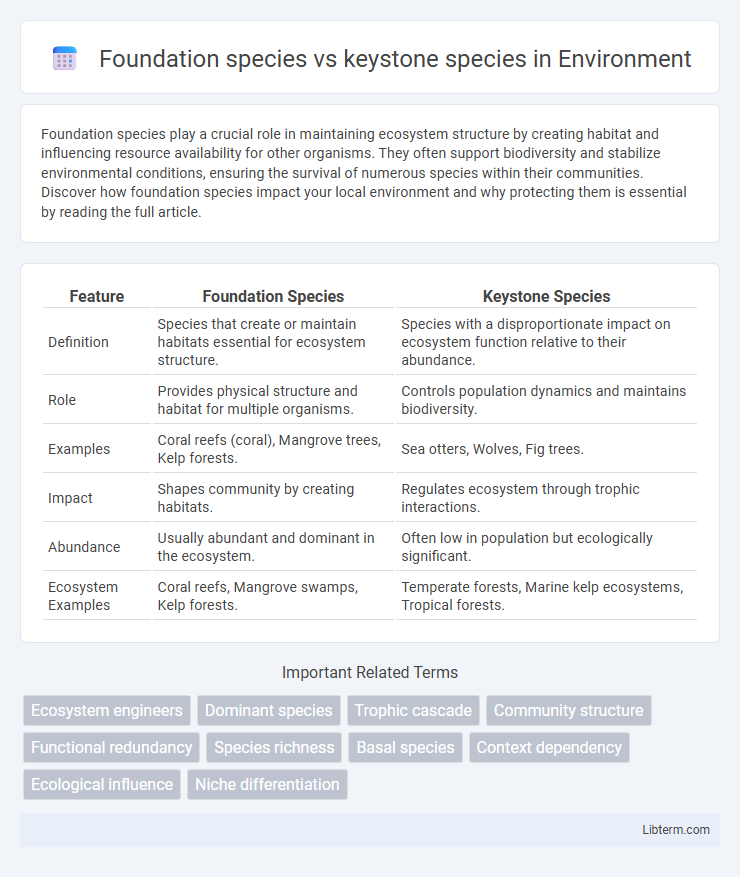Foundation species play a crucial role in maintaining ecosystem structure by creating habitat and influencing resource availability for other organisms. They often support biodiversity and stabilize environmental conditions, ensuring the survival of numerous species within their communities. Discover how foundation species impact your local environment and why protecting them is essential by reading the full article.
Table of Comparison
| Feature | Foundation Species | Keystone Species |
|---|---|---|
| Definition | Species that create or maintain habitats essential for ecosystem structure. | Species with a disproportionate impact on ecosystem function relative to their abundance. |
| Role | Provides physical structure and habitat for multiple organisms. | Controls population dynamics and maintains biodiversity. |
| Examples | Coral reefs (coral), Mangrove trees, Kelp forests. | Sea otters, Wolves, Fig trees. |
| Impact | Shapes community by creating habitats. | Regulates ecosystem through trophic interactions. |
| Abundance | Usually abundant and dominant in the ecosystem. | Often low in population but ecologically significant. |
| Ecosystem Examples | Coral reefs, Mangrove swamps, Kelp forests. | Temperate forests, Marine kelp ecosystems, Tropical forests. |
Introduction to Foundation and Keystone Species
Foundation species create and maintain habitats that support entire ecosystems by significantly shaping the physical environment and influencing community structure. Keystone species have a disproportionate effect on ecosystem dynamics relative to their abundance, often controlling population sizes and maintaining biodiversity through trophic interactions. Understanding the distinct roles of foundation and keystone species is essential for effective conservation and ecosystem management strategies.
Defining Foundation Species
Foundation species are organisms that create or significantly modify habitats, providing essential structural support and resources that sustain diverse biological communities. Unlike keystone species, which exert influence primarily through trophic interactions, foundation species often form the physical framework of an ecosystem, such as corals in reefs or trees in forests. Their presence stabilizes environmental conditions and promotes biodiversity by shaping ecosystem processes and providing shelter, food, or breeding grounds for numerous species.
Understanding Keystone Species
Keystone species play a critical role in maintaining the structure and balance of an ecosystem by influencing the abundance and diversity of other organisms. Unlike foundation species that create habitat and support community structure through their physical presence, keystone species exert their effect primarily through ecological interactions such as predation, mutualism, or competition. Examples like the sea otter controlling sea urchin populations or wolves regulating deer numbers demonstrate how keystone species prevent ecosystem collapse and promote biodiversity.
Key Differences Between Foundation and Keystone Species
Foundation species create and maintain habitat structure, significantly influencing community composition by providing essential resources and shelter. Keystone species exert a disproportionate impact on ecosystem dynamics relative to their abundance through top-down effects such as predation or mutualism, often regulating population balance. The primary difference lies in foundation species shaping the physical environment, whereas keystone species primarily influence biological interactions within the ecosystem.
Ecological Roles and Functions
Foundation species create and maintain habitats that support diverse biological communities by dominating physical structure and biomass, such as corals in reefs or mangroves in coastal ecosystems. Keystone species exert disproportionate influence on ecosystem structure and function through trophic interactions or ecological processes despite their low abundance, exemplified by predators like sea otters controlling sea urchin populations. Both roles are critical for biodiversity and ecosystem stability, with foundation species shaping environmental conditions and keystone species regulating community dynamics and trophic cascades.
Impact on Biodiversity and Ecosystem Stability
Foundation species, such as corals and trees, create and maintain habitats that support diverse biological communities by providing structure and resources essential for numerous species. Keystone species, including predators like wolves or sea otters, regulate population dynamics through trophic interactions, preventing dominance by any single species and thus promoting ecosystem balance. Both types profoundly influence biodiversity and ecosystem stability, with foundation species shaping physical environments and keystone species shaping community interactions.
Examples of Foundation Species
Foundation species such as mangroves, corals, and giant kelp create and maintain habitats that support diverse ecosystems by providing shelter, food, and stabilizing environmental conditions. Mangroves protect coastlines from erosion while supporting marine life, corals form complex reef structures essential for thousands of species, and giant kelp forests supply oxygen and serve as nursery grounds in temperate ocean waters. These species shape the physical environment, making them crucial for ecosystem stability and biodiversity.
Examples of Keystone Species
Sea otters exemplify keystone species by controlling sea urchin populations that threaten kelp forests, maintaining ecosystem balance. Wolves regulate prey populations like elk, preventing overgrazing in North American forests and promoting biodiversity. Beavers create wetlands through dam building, supporting diverse aquatic and terrestrial organisms, highlighting their keystone role.
Conservation Implications
Foundation species such as mangroves and corals create and maintain habitats, supporting biodiversity by stabilizing ecosystems and providing essential resources. Keystone species like wolves and sea otters regulate population dynamics and trophic cascades, ensuring ecological balance by controlling prey populations. Conservation strategies emphasize protecting foundation species to preserve habitat integrity and keystone species to sustain ecosystem functionality and resilience.
Summary and Future Directions
Foundation species create and maintain habitat structure, supporting biodiversity and ecosystem stability, whereas keystone species exert disproportional influence on ecosystem function despite low abundance. Research increasingly emphasizes understanding the complex interdependencies and identifying these species through advanced ecological modeling and empirical studies. Future directions include leveraging genetic tools and remote sensing to refine species roles, improving conservation strategies to prioritize ecosystem resilience under climate change.
Foundation species Infographic

 libterm.com
libterm.com